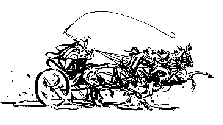The Case for Early Castration...
A CASE FOR EARLY CASTRATION
Many of us are weaning foals. Of course about one half of these weanlings are male or stud colts. By now, at the age of four to six months, you have come to realize there is a behavioral difference between the studs and fillies. The fillies may nuzzle you and play a little rough in the field with the other foals. The little studs will be bitting or rearing on you, and will be the main instigators of rough and tumble play among the foal group. Some of the stud colts will have already assumed their role as stallion. Each day they practice rearing up on mother and any other foal they find still for a moment.
If you keep the foals until they are yearlings, the time will come when they have to be separated. Neither sex will be mature yet, but the time of maturity is not scheduled and can happen when we have our backs turned.
One of the ways to alleviate the above problems, for the stud colts not destined for breeding service, is to castrate them. The most popular time we perform this surgery is during the spring when they turn one year old. This is when the hormones are running at high levels and they become intolerable. By now they are bitting, rearing, and running through any obstacle to be near other horses. Castration at this time will alleviate most of this, but some of the irritating vices will have to be corrected.
If we have the opportunity to castrate the foals before they are weaned, anytime after three months of age, many of these bad habits never come to pass. Surgery this early will cause little stress on the colt. They stay with mom for another month or so, depending of course on when the signs are right for weaning. They will be healed within a couple of weeks and will not have had time to learn the bad habits of older studs.
The main argument for waiting until the foal is over a year of age before castration is to allow time for development of the neck and head. With time and the influence of testosterone, the neck will thicken and the jaw grow more prominent. Of course there will be a general overall thickening of the body. If castrated early, most of this thickening will not occur. However, the anatomy people, who are supposed to know these things, tell us the stallion will lose 60 % of this [testosterone-induced] muscle after he becomes a gelding at whatever age. The difference is not enough to be significant.
The one time we might encourage waiting until the foal is older before surgery is when one or both testicles are still retained within the abdomen. If they cannot be felt in the scrotum or the inguinal canal leading to it, a little more time may in indicated. Most of these lost testicles will show up in the scrotum after the first year. If they have not descended by the time the colt is two, it is time to recover them from the abdomen and complete castration by removing both testicles. This condition is considered a hereditary trait and can be passed on to future generations.
For almost trouble free care of male colts, consider early castration. They will be easy to handle, will interact with their herd mates in a gentler and kinder manner, and will not require special accommodations after their first year. In addition, surgery is less expensive at this age. So there are many more advantages then disadvantages.
CLICK BELOW TO DISPLAY A PRINTER-FRIENDLY COPY OF THIS ARTICLE
Select "Open this file from its current location," if you just want to print it out,
it will open in a simple word processing application, select the print button.
(unless you want to save this article in your computer's memory)

 ACaseForEarlyCastration.rtf
ACaseForEarlyCastration.rtf